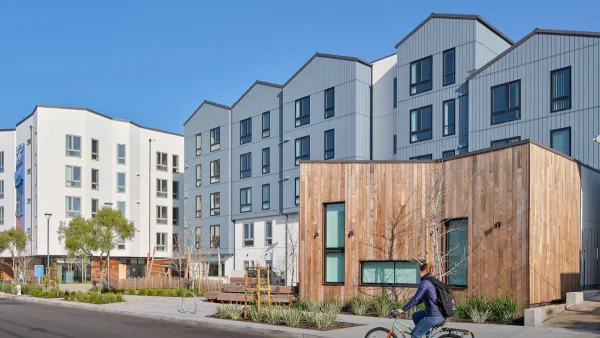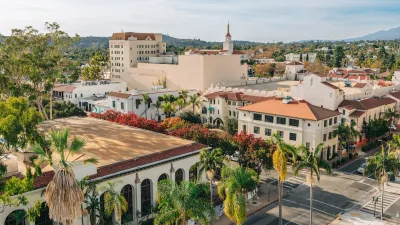By any measure, the HUD that is now emerging from the shadows of eight years of amateur hour, is focused on the right things: markets, coherent roles for public and private sector alike, and energy efficiency. Indeed the emphasis on "urbanism" and "regionalism" illustrates that this administration "gets it".
By any measure, the HUD that is now emerging from the shadows of eight years of amateur hour, is focused on the right things: markets, coherent roles for public and private sector alike, and energy efficiency. Indeed the emphasis on "urbanism" and "regionalism" illustrates that this administration "gets it".
What's not at all clear is whether our wider community development industry, such as it is, does as well, or will, and what role the various housing and urban affairs committees on Capitol Hill will play as the economy bottoms out, and Stimulus dollars begin to hit the street.
Two seemingly disconnected articles appeared in this morning's Washington Post that serve as excellent reminders that we would all do well to keep in mind the adage "the more things change...."
Deneed Brown does an admirable job of describing the high costs of being poor in America. The article (Poor, Pay Up) (http://www.washingtonpost.com/wp-dyn/content/article/2009/05/17/AR2009051702053.html), articulates the many expenses and indignities of being poor, notably high costs for less quality groceries. The article serves as a poignant reminder that the concentration of poverty remains the single most pressing housing and urban affairs challenge of our times, separate and married to the economic development challenge of eradicating poverty, and quite more serious that any gain from the production of more affordable housing in the wrong place.
In another piece, the Post covers the issue of Stimulus dollars aimed at cleaning up nuclear waste going to contractors that have a poor record of past performance. As the article notes, "The very contractors that have been responsible for cost overruns and serious delays have proposed how to pump stimulus money back into the project," said Gerry Pollet, executive director of Heart of America Northwest, an environmental watchdog group. The companies "are set to get hundreds of millions of dollars on top of the money they've already received, for the same projects they've seriously mismanaged." (http://www.washingtonpost.com/wp-dyn/content/article/2009/05/17/AR2009051702254.html?hpid=topnews)
How is the shoddy record of environmental cleanup contractors now receiving Stimulus dollars connected to the concentration of poverty in America, and to the new HUD agenda, and the community development field?
At the center of the Stimulus feeding frenzy for HUD monies is the rush to be awarded what may be known as NSP contracts. NSP stands for Neighborhood Stabilization Program, and was originally an element of the HERA bill that last summer generated billions of dollars for communities to address foreclosure impacts on neighborhoods.
A terribly schizophrenic effort - half the time focused on neighborhoods as markets, the other half on affordable housing - it nevertheless forced many communities to at least think about market and submarket viability. A small number of cities showed courage and crafted NSP strategies actually aimed at the corrosive effects of concentrated poverty and the viral impacts of foreclosure and abandonment and the challenge of succession. Others interpreted the loopholes left in the statute to undertake a range of uncreative efforts that at best were mere "CDBG-stretch" exercises; essentially taking the NSP I dollars and doing "more of the same" since, well, there was more, and "the same" seemed easy enough.
Now we have NSP II, which is (thankfully) night and day from NSP I. II is a thoughtful recalibration of how to spend urban development dollars: use geography carefully, establish a deployment criteria, be aggressive, insist on metrics. There are problems with NSP II (a large swatch of weak market America is not eligible for II dollars because it is not weak enough), but given the quality of II, such shortcomings are small potatoes.
NSP II is just less than $2B for weak areas to try to stabilize their markets, whether the weakness owes to long term abandonment or recent foreclosure impacts. Yet like nuclear waste cleanup contacts going to Bechtel Jacobs, local guidance on NSP II is being provided by the very same community development infrastructure that failed to address blight in Baltimore and Hartford and Norfolk and Fresno and...
Moreover, roughly $50M in technical assistance dollars is hitting the street to enable a cadre of contractors to supply advice on how to stabilize neighborhoods. What is happening is the very same organizations - and more importantly the very same kinds of thinking about neighborhoods and housing - that for years have insisted on permanent housing affordability and all low-income projects and that pushed a senseless "let's build it and the neighborhood will be fixed" mantra - are cueing up. The same tired default option is apt to emerge, there being no change in who is peddling which scheme, which is local marginal capacity CDCs engaged in one-off acquisition-rehab-sale efforts, funded and advised by the same intermediaries that thought another all low-income tax credit deal in a ghetto was just the ticket. This is like giving Dairy Queen the contract to help America slim down.
The emerging blueprint emphasizing regionalism and markets, geographic targeting, rigorous deployment criteria, and choice, all show that wisdom has returned to urban affairs at HUD. But schizophrenia remains about how much to focus on affordable housing and how much on neighborhood health. As such, unless the TA dollars that are flowing in conjunction with NSP program dollars are as wisely allocated as NSP II was recrafted, tired thinking will make its way to local decision making and planning efforts, poverty will remain concentrated, and neighborhood stability will remain elusive. It is too often the case that state and local government neither knows how to break old habits themselves, nor has meaningful guidance on the subject by objective parties.
What both appear to most want is some of the pie, rather than resources to approach their urban challenges in fundamentally different ways. Not because they don't care, but because the old way is often easier. Do you want to be the local housing director trying to explain to some city council members why dollars are not going into areas where success isn't likely?
Part of the work of moving forward with anything is figuring how much of the past to let go of. The record of the community development field the past 30 years - with a brief exception for the spirited and creative HOPE VI work - is a sober reminder that most of what we have done constitutes what we need to stop doing.
Hopefully NSP II can begin the process of eliminating a range of housing and community development's bad habits.

Planetizen Federal Action Tracker
A weekly monitor of how Trump’s orders and actions are impacting planners and planning in America.

Map: Where Senate Republicans Want to Sell Your Public Lands
For public land advocates, the Senate Republicans’ proposal to sell millions of acres of public land in the West is “the biggest fight of their careers.”

Restaurant Patios Were a Pandemic Win — Why Were They so Hard to Keep?
Social distancing requirements and changes in travel patterns prompted cities to pilot new uses for street and sidewalk space. Then it got complicated.

Platform Pilsner: Vancouver Transit Agency Releases... a Beer?
TransLink will receive a portion of every sale of the four-pack.

Toronto Weighs Cheaper Transit, Parking Hikes for Major Events
Special event rates would take effect during large festivals, sports games and concerts to ‘discourage driving, manage congestion and free up space for transit.”

Berlin to Consider Car-Free Zone Larger Than Manhattan
The area bound by the 22-mile Ringbahn would still allow 12 uses of a private automobile per year per person, and several other exemptions.
Urban Design for Planners 1: Software Tools
This six-course series explores essential urban design concepts using open source software and equips planners with the tools they need to participate fully in the urban design process.
Planning for Universal Design
Learn the tools for implementing Universal Design in planning regulations.
Heyer Gruel & Associates PA
JM Goldson LLC
Custer County Colorado
City of Camden Redevelopment Agency
City of Astoria
Transportation Research & Education Center (TREC) at Portland State University
Camden Redevelopment Agency
City of Claremont
Municipality of Princeton (NJ)






























